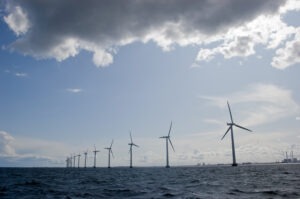The Johns Hopkins Wind Energy Team made a significant impact at the 2022 Collegiate Wind Competition (CWC), despite it being just the second time the group had competed at the event.
The team, which is mentored by Dennice Gayme, an associate professor in the Department of Mechanical Engineering and a member of the ROSEI Leadership Council, placed first in the Project Development subcategory. One of four smaller competitions that combine to create a team’s final score, the Project Development subcategory asks students to assess wind farm development opportunities within a defined region, create a development plan, and prepare a bid for a lease area.
“We had a diverse group of students tackling this problem who had a wide array of focuses in their studies, including finance, environmental studies and the policy side. There are two groups that took on this category, one was siting and the other was finance, and we really emphasized bridging the gap between the two and working together,” said Lance Kotler, a recently graduated senior that majored in International Studies, Economics, and Political Science who was one of the leads of the finance team.
That extra communication and various perspectives were necessary this year, as the committee with the CWC – which is hosted by the United States Government’s Office of Energy Efficiency & Renewable Energy – threw a couple curveballs in the scenario.

The CWC committee made the Project Development subcategory more challenging this year by having the site be offshore.
The location for the hypothetical wind farm was just off the coast of Galveston, Texas. In other words, an offshore site. With only two operational wind farms existing in the United States, as well as it being the first time the committee was asking the teams to create an offshore site, there was very little data for the team to work with.
“Last year we had previous competition papers that we could refer to for source material, but we didn’t have as much to work with for this competition,” said Kyra Rothwell, a recently graduated senior that majored in Chemical and Biomolecular Engineering and Economics who was the siting team lead. “They also didn’t specify the size of the wind farm. It could be any size you wanted it to be, so that presented an iterative optimization problem that both of our groups had to tackle together. We had to balance a lot of different costs as well as the constraints of where you could feasibly put a wind turbine.”
The team’s hypothetical windfarm ended up being 370.5 megawatts, but that wasn’t the end of their work. In addition to the yearlong project, the team also had to complete a similar siting prompt at the in-person portion of the CWC Competition, which took place at the Clean Power 2022 Conference in San Antonio, Texas.
“Working through those type of real world challenges is exactly why students at Hopkins who are interested in pursuing a career in renewable energy should join the team” said Guy Van Syckle ’12, a Director of New Markets with Hannon Armstrong, a company that is solely dedicated to investments in climate solutions, providing capital to assets developed by leading companies in energy efficiency, renewable energy, and other sustainable infrastructure markets.
Van Syckle joined the group of Hopkins students for a call every two weeks to map out their progress. A couple weeks before the competition Van Syckle joined a panel comprised of industry colleagues, which was able to give the group valuable feedback.
“We review projects with similar risks and similar models at Hannon Armstrong. Even just the modeling skills the students gain prep them extremely well for a role investing in sustainable infrastructure projects. Keep in mind, that is just on the project development side, the work students put in on the engineering side is similarly useful and relevant,” Van Syckle said. “The team’s hard work and growth over the project sets them up well to be future leaders in clean energy and seeing such committed young folks makes me feel a bit better about our climate trajectory. .”
Simply getting to attend the competition has also paid dividends for members of the team, too. As a recently graduated senior, Rothwell is currently job hunting, and many leads she is following are coming from connections she made at the Clean Power Conference.
“Our competition was in one room, but just across the hall there was a showroom with booths and industry professionals talking about renewable energy. It was great having so many people in one area where you could network, and I’m hopeful I’ll find a job soon from those connections,” Rothwell said. “Being a member of this talented and hardworking team has been incredible. This project is the most significant part of my college experience that has made me feel ready to start a career. It helped me consider what I want to do professionally, develop real-world skills, and then gave me opportunities to speak with people who could help me find a job in the field.”